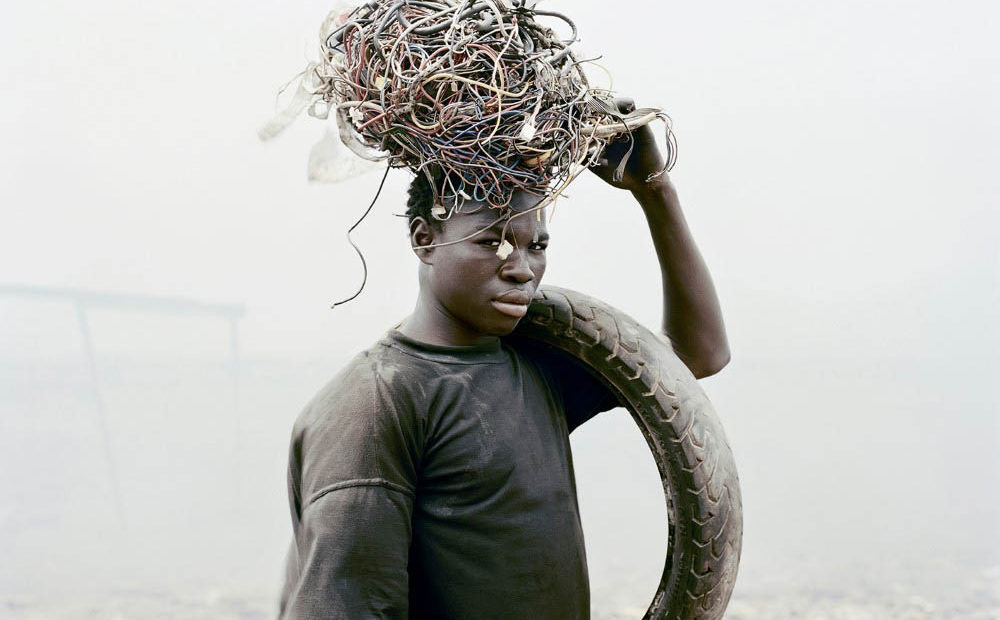Deutsche Börse Photography Prize 2012 at the Photographers’ Gallery

The four short-listed artists for this year’s photography prize produce work from disparate ends of the photography spectrum, from the hauntingly placed photo-montages of John Stezaker to the gentle and hazy visual experience from inside Rinko Kawauchi’s head.
All these bodies of work imply some solitary obsession or endless pursuit. The story behind Pieter Hugo’s Permanent Error, a record of a technological dump in Ghana, is one of a journalist veering off-track to follow a lead, finding something very meaningful and needing to document it. Hugo’s work is the only one of the four to be presented as large and arresting prints, as perfect in detail as fine art or even fashion as fine art; one can’t help but remember Jason Evans and Simon Foxton’s series of portraits of young black men, with their dead-pan posing and sartorial dress. But this wasteland is a world away from the technological rubbish that fills it and the high-art world it now partially inhabits. On the screens of a stack of televisions on the floor, the eerie landscapes come to life as apocalyptic smoke rises, but the men stand perfectly still.
In the same room on the top floor, the space is shared by Rinko Kawauchi, who keeps her explorations closer to home. Intimate small-scale photographs of details from her life are made otherworldly by her camera, a flower disappears into overexposure, and a diamond explodes with refracted light. In an accompanying recording Kawauchi explains: “Light is a symbol of life. I’m interested in light because I’m attached to life”. It seems that both artists in this room have their philosophies of life and death: Kawauchi’s literal lightness is a contrast to Hugo’s purgatory for obsolete objects, two versions of scenes removed from time. The space of the newly renovated gallery lends more to Hugo’s work and seems to swallow up the delicacy of Kawauchi’s images and videos.
Two more artists play with time, life and human connections in the room downstairs. Both John Stezaker and Christopher Williams’ work carry with them a sense of the past. John Stezaker’s images must by now be well-known after his retrospective at the Whitechapel Gallery last year. Maybe because of this familiarity his most successful images in this environment are the subtle and unsettling Third Person Archive, isolated figures seen from very far away, alone in the centre of a gaping page. It is perhaps the vintage archival quality of Stezaker’s found images which invites a warm reaction. Stezaker himself speaks of making a “human connection,” bringing us back to that idea of a solitary artist creating work to reach people.
The opposite is true with Williams’ photographs, saturated with colour, of machinery and photographic equipment. His work is the most conceptual of the lot, leaving less to emotion than the other short-listers and instead borrowing from the aesthetic of a classic advertising style. Again, seen on these white walls, Williams’ work packs less of a punch than as previously seen in print format, especially remembering his cover for Art Forum of a smiling woman in yellow towels, one round her body and the other around her hair. The selection at the Photographer’s Gallery is colder despite the perfect colours.
All four artists will be giving talks at the Photographer’s Gallery starting from 24th July for all exhibition-goers who wish to gain a further insight into their work before the winner is announced on the 3rd September.
Sarah Cleaver
The Deutsche Börse Photography Prize exhibition is at the Photographers’ Gallery until 3rd September 2012. For further information visit the gallery’s website here.




















Facebook
Twitter
Instagram
YouTube
RSS